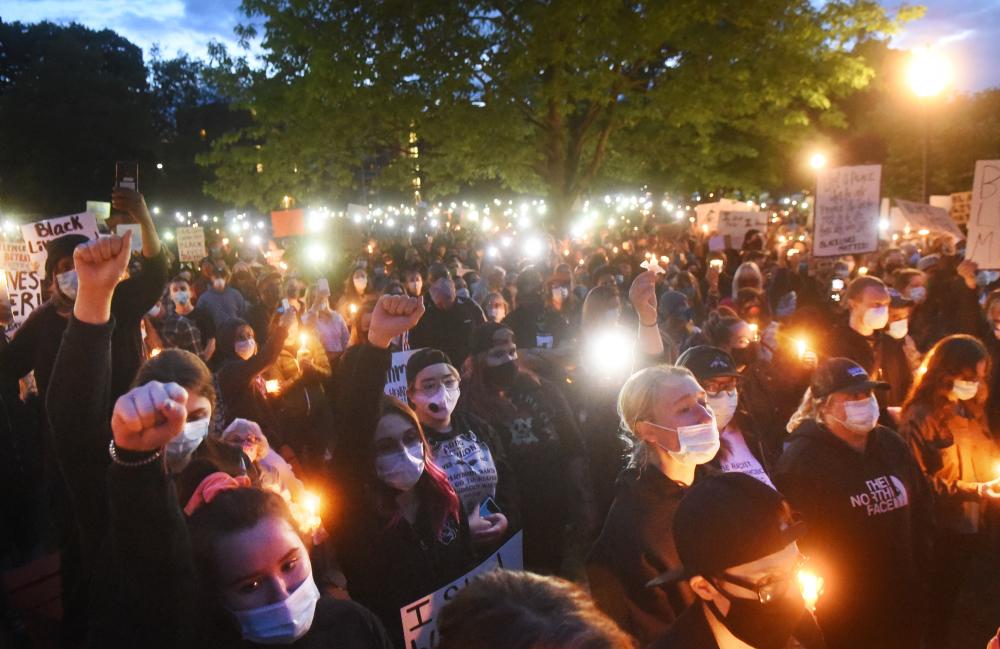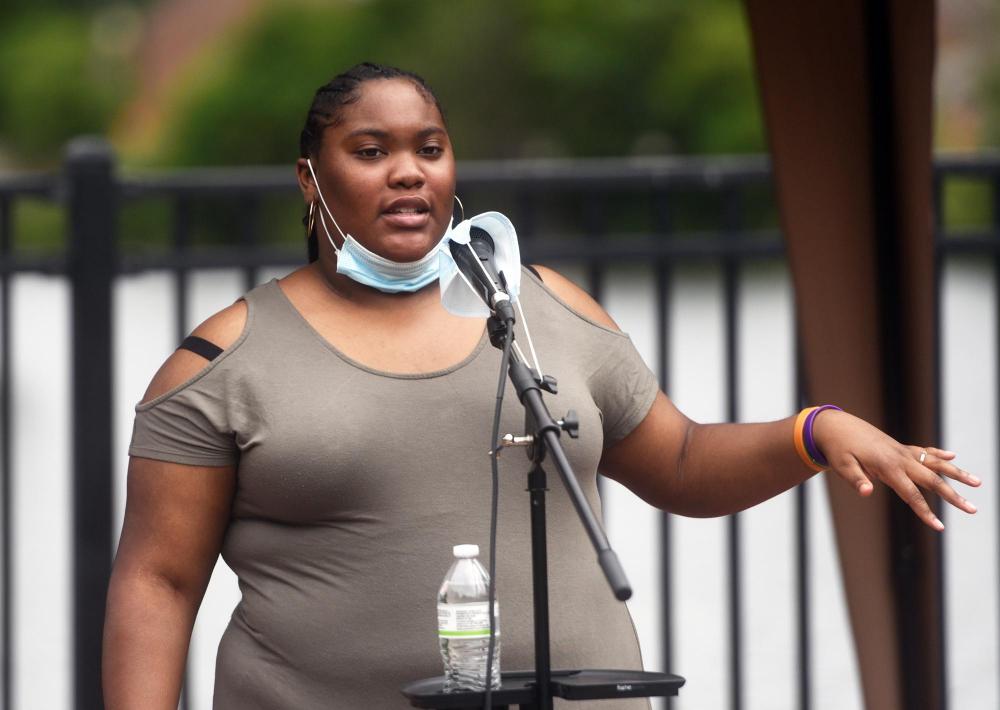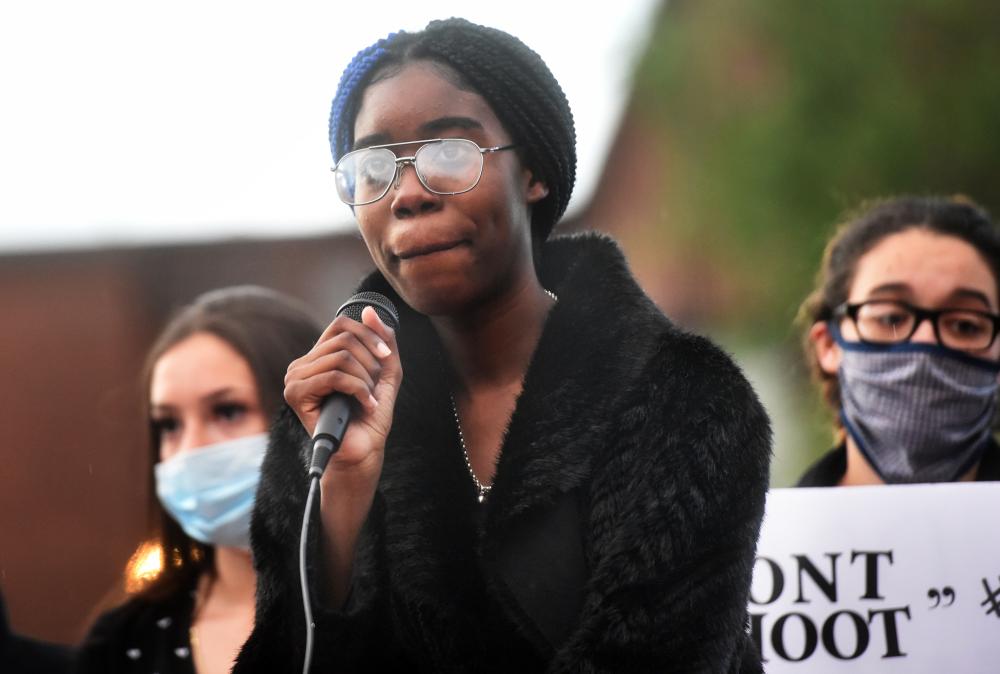
Project D.R.E.A.M. holds a candlelight vigil for George Floyd March 22, 2021 at Henry Law Park in Dover (Photo by Deb Cram, Seacoastonline and Fosters.com)
In 2015, a tattoo artist named Raymond Stevens pleaded guilty to criminal mischief after defacing the homes of refugees in Concord with racist graffiti.
The hateful words scrawled on the siding were literal and clear: "You are not welcome here." Under the state's Civil Rights Act, prosecutors applied a hate crime enhancement to Stevens' sentence, resulting in a year of imprisonment in a county jail.
Hate crimes are often referred to as message crimes—those that target and intimidate an entire group as well as the direct victim. In a 2012 study published in the International Review of Victimology, researchers found that people who were aware of hate-based violence against someone in their community experienced similar symptoms to victims of vicarious trauma, reporting feelings of shock, anger, fear and inferiority.
This 'in terrorem' effect of hate crimes is often cited as one of the reasons specific laws addressing them are necessary. But with varying definitions from state to state, inconsistent investigation and reporting by law enforcement and the legal hurdle of proving the intent of the perpetrator, hate crimes remain vastly underreported and rarely prosecuted, leading some to question the effectiveness of this type of legislation.
Incidents decried by the community as hate crimes often don't end up labeled that way in the courtroom. In 2019, for example, the state's Civil Rights Unit determined that the near-hanging of a biracial boy in Claremont didn't meet the criteria for a hate crime sentencing enhancement. The 13-year-old who pushed the 8-year-old boy off a picnic table while he had a rope around his neck pleaded guilty to misdemeanor simple assault. He had previously used racial epithets against the 8-year-old, but the state said there wasn't enough evidence to prove the crime was racially motivated.
These statutes also can't address instances of racism, hate and bias where a crime hasn't been committed, such as the 2018 incident at Dover High School when a group of students wrote a jingle about the KKK for a history class assignment, which featured a refrain of “Let’s kill all the Blacks."
“A person may engage in conduct that may be very harmful and upsetting to the diverse and different communities in New Hampshire, because it may be racialized speech, it may be anti-Semitic, it may be homophobic or transphobic,” Sean Locke, director of the NH Attorney General’s Civil Rights Unit, explains. “But ultimately, it isn’t kind of crossing that threshold into trying to encourage violence against those communities.”
In a state like NH, where roughly 90% of residents are white, it's not uncommon for incidents like these to be treated as an isolated occurrence. However, experts say that a lack of diversity doesn't translate to a lack of racism, and communities can't begin to confront hate and bias in their midst without first acknowledging that it's there.
That's why they say responses to hate must reach beyond the law into classrooms, workplaces and community spaces—because all hate is harmful, whether or not it meets the legal definition of a hate crime.
“If we’re going to be anti-racist and direct our work towards eliminating forms of hate and bias, we shouldn’t just be doing it on the criminal side,” says Robert Trestan, regional director of the Anti-Defamation League New England. “We need to be doing it in other areas of society.”
Creating a Culture
Experts point to education as an essential tool for preventing hate-based extremism and violence. At the same time, reports of hateful acts in schools in recent years have sparked concern that these incidents are on the rise.
Christina Cliff is an assistant professor of political science and security studies at Franklin Pierce University. According to Cliff, whose research focuses on violent political extremism, building inclusive communities is paramount to prevention efforts. And though NH is becoming more diverse, it’s still one of the whitest states in the nation, making it a potential target for extremists looking to recruit, she says.
“Racist white supremacists see New England as a potential great home base, because of the demographics in New England primarily,” Cliff says. “It’s predominantly white up here, it’s a lot of rural space, our cities are small by comparison. So they see this as sort of, ‘Hey, there are potentially avenues here where we can talk about what we believe is correct.’”
The Southern Poverty Law Center identified six hate groups that were active in NH in 2020, including two neo-Nazi groups, two anti-Muslim groups, a white supremacist group and a sect of radical Catholicism. And the Anti-Defamation League tracked 56 extremist and anti-Semitic incidents in the state last year: two white supremacist events, seven anti-Semitic incidents and 48 instances in which white supremacist propaganda was distributed.
But Cliff notes that extremism is not limited to organized factions like these. Many people begin to adopt these ideologies by connecting with others individually, both in person and online, she says. And exposure to one form of extremism, such as anti-government rhetoric, can lead to exposure to other types of extremism like white supremacy, especially in online communities and forums. As mis- and disinformation continues to permeate social media and online spaces, young people can be particularly vulnerable to these movements.
“We don’t think of social isolation for teenagers or things like that … but that’s a potential driver towards extremism, because extremists offer them a sense of community and offer them a sense of feeling like they’re doing something important or powerful,” Cliff says.
Facing History and Ourselves, a Brookline, Mass.-based nonprofit organization, creates resources to help educators address hate in the classroom. In the wake of something like the Jan. 6 insurrection at the United States Capitol, where hate symbols including Nazi and Confederate flags were prominently displayed, the organization believes it’s crucial that teachers have an open discussion with their students about what’s happened.
That starts with asking students how they’re feeling about what they’ve seen, according to Laura Tavares, the nonprofit’s program director of organizational learning and thought leadership. The question can lead into discussions around justice, responsibility, human behavior and the ways students can use their voice, she says.
“When we don’t talk about what we see happening around us, with our neighbors being targeted with hate speech or hate crimes, we risk giving our students the impression that those things are normal or acceptable,” Tavares says.
When it comes to encouraging these discussions in classrooms, NH has made recent progress with the passage of a bill mandating Holocaust and genocide education in the state’s public schools, which Trestan described as a potential model for other states.
“That’s important, because it’s not just about the Holocaust, but it’s also looking at other examples of more contemporaneous genocides that have happened,” Peter McBride, director of the Center for Holocaust and Genocide Studies at Keene State College, says. “And the intention I think behind it is to help people understand the big cry after the second world war and the Holocaust was, ‘Never again.’ And yet, we end up seeing it again and again, so the lessons are not being learned.”
The first step, experts agree, is acknowledging that racism, hate and extremism are still very much a threat in NH. And the next step is talking about it.
“Probably everybody knows somebody that holds a line of thinking that could lead them down to extremism,” Cliff says. “If we recognize that it’s in our towns and it’s in our cities, I think we have a better chance of addressing it, educating ourselves about it and trying to do what we can to limit its impact.”
In the Aftermath
At Dover High School, the past few years have been focused on these conversations.
It started in 2018, when a video of a group of students singing a jingle about the KKK began to circulate on social media. They’d written the song, which was set to the tune of Jingle Bells, for a history assignment about the Reconstruction Era.
Their teacher, John Carver, was placed on paid administrative leave and returned to the high school the next year after undergoing racial bias training, drawing criticism about his reinstatement from racial justice activists and leaders.
“I didn’t really think a lot of students would take his side, but it caused a divide,” says Dover High senior Miraqle LaPierre of the school’s atmosphere after the video became public. “It was either you agree or you don’t agree with how the video got out and everything else.”

Miraqle LaPierre, a Dover High senior and member of Project D.R.E.A.M. (photo credit: Seacoastonline and Fosters)
Since then, the district has held several community forums, created a steering committee focused on racial equity and provided additional professional development and training to faculty and staff.
For senior Prastabana Pokhel, it felt like things started to shift after she attended a forum where students of color were given the opportunity to share their thoughts and experiences with racism at the high school.
“It just felt like there was so much emotion being released, like it was held back. And then I just heard so many people’s stories, and it was just—I don’t know, like a reset kind of,” she says. “It felt like there was a community in Dover that you previously hadn’t felt before.”
The experience led her to join Project D.R.E.A.M., a student group that formed following the incident with the goal of making Dover High a more equitable place. The name stands for diversity, respect, educate, advocate and mission, and the club is open to everyone, though many of its members are students of color, and it has since become affiliated with the Seacoast chapter of the NAACP.
According to Superintendent William Harbron, Project D.R.E.A.M. has been essential in guiding the district’s work around equity and inclusion in the wake of the jingle video.
“The situation caused us to look really hard at ourselves and say, yes, it exists here. We’ve got to do something about it,” he says. “I think if you had to look at a positive of that situation, I think it was a catalyst, just to make us more committed and more focused on the issue.”

Palmira Wilson, a Dover High School student and co-founder of Project D.R.E.A.M., speaks at a peaceful protest rally for George Floyd (Photo by Deb Cram, Seacoastonline and Fosters.com)
Students from the club have provided input to the district’s Racial Equity Vision Keepers committee, a steering committee that’s developing a strategic plan for the district’s equity efforts. They also helped to bring the Department of Justice’s SPIRIT program to Dover, a one-day workshop where more than 100 students gathered to discuss cultural issues impacting the student body.
“It started the conversation that needed to be had, because within the school, there just wasn’t any conversations happening unless you were in a club like D.R.E.A.M.,” says junior Javien James, a member of the group who was involved in organizing the SPIRIT event.
The students agreed that the district has made good progress in the last few years. But there’s still work to be done—they would like to see more teachers of color in the hallways, for example, and a more inclusive curriculum.
“I’m not saying that the teachers at Dover don’t push you to be what you want to be in life. But I’m saying if it was to come from someone who looked like me, it would most definitely mean a lot more, I guess you can say,” says LaPierre, who has been involved with Project D.R.E.A.M. since its inception. “Because that person once walked in my shoes.”
The students are also pushing for more accountability. LaPierre recounts filing reports with administrators about students using racial epithets, only to never hear anything more about the issue. Several of the students also say they were frustrated that Carver kept his job but, to their knowledge, never publicly apologized for what happened in his classroom in 2018.
“I understand his official thing to his students was like, ‘I understand what happened, but no 17-year-old should be penalized for something they did when they were 17.’ That was pretty much his entire explanation,” Pokhel says. “Besides that he hasn’t said anything about the incident. It’s pretty much swept under the rug.”
Carver did not respond to a request for comment.
That hasn’t stopped Project D.R.E.A.M. from doing its work, and neither has COVID-19. They’re still meeting weekly on Zoom, and they’ve started an Instagram page where they share educational posts. But more than that, it’s become a community. James says the club was the first place he felt included at Dover High. For other students, it’s been the place where they found their voice.
“I think D.R.E.A.M. just kind of pushed me to actually be like, ‘Okay, just because you’re a teenager doesn’t mean people aren’t going to listen to you,’” LaPierre says. “Especially if you have something to say and it’s important.”
Granite State News Collaborative Researcher John Bassett contributed to this report.
This article is part of a multi-year project exploring race and equity in New Hampshire produced by the partners of The Granite State News Collaborative. For more information, visit collaborativenh.org.

 Current Issue - April 2024
Current Issue - April 2024